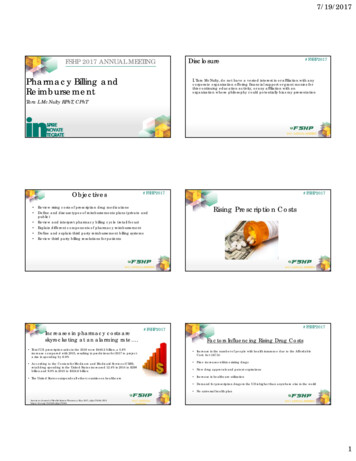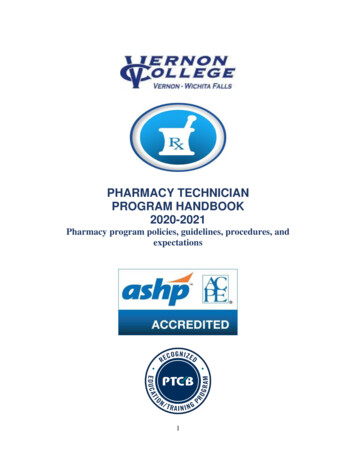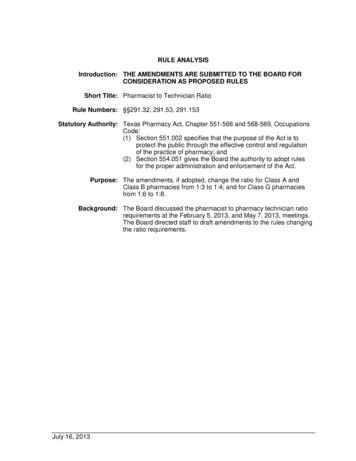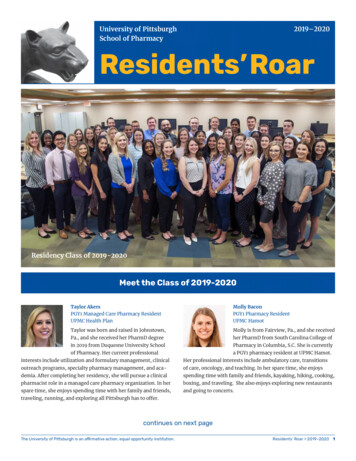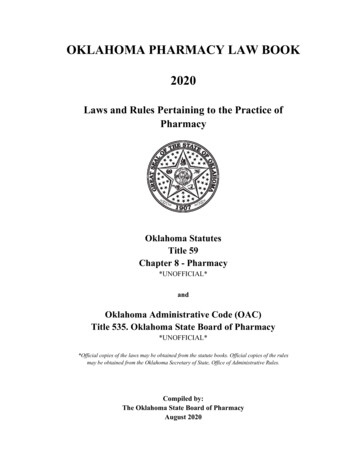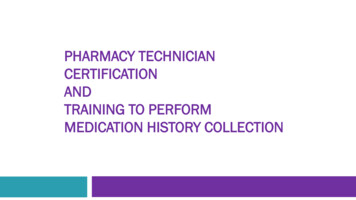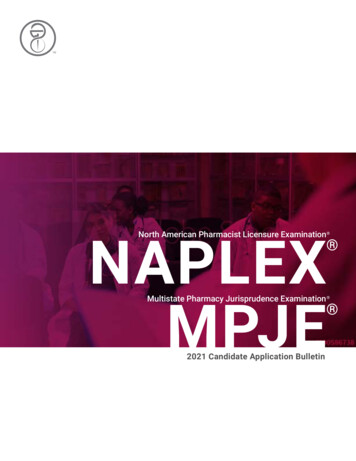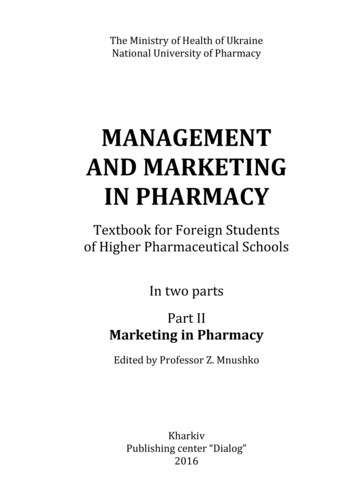
Transcription
The Ministry of Health of UkraineNational University of PharmacyMANAGEMENTAND MARKETINGIN PHARMACYTextbook for Foreign Studentsof Higher Pharmaceutical SchoolsIn two partsPart IIMarketing in PharmacyEdited by Professor Z. MnushkoKharkivPublishing center “Dialog”2016
UDC 615.1:65.050:339.138(075)LBC 51.1(2) 52.82я73M50Approved by Ministry of Education and Science of Ukraine(letter 1/11-16529 dated October 15, 2012)Authors: Mnushko Zoia M., Pestun Iryna V., Timanyuk Iryna V., Sofronova Iryna V.,Aliekperova Nataliia V.Reviewed by:Grochoviy T. – Head of Department of Pharmaceutical Science of I. Ya. Gorbachevsky Ternopil State Medical University, Doctor of Pharmacy, Professor;Kabachna A. – Professor of Department of Management and Economics in Family Medicineof Kharkiv Medical Academy of Postgraduate Education, Doctor of Pharmacy, Professor;Toryanyk L. – Associate Professor of Foreign Languages Department of National Universityof Pharmacy, PhD in Pedagogy, Associate Professor.Management and Marketing in Pharmacy [Electronic resource] : the textbook forM50 foreign students of higher pharmaceutical schools : in 2 parts / Z. Mnushko [at al.], ed. byprof. Z. Mnushko ; National University of Pharmacy. – Electronic text data. – Kharkiv :Publishing center “Dialog”, 2016. – Part II : Marketing in Pharmacy. – 1 electronic opt. disk(CD-R). – 3,7 Mb. – System requirements: Adobe Acrobat Reader. – Title from the disk label.ISBN 978-617-7357-01-7ISBN 978-617-7357-03-1 (Part II)The textbook presents the basic theoretical principles of marketing and characteristics of pharmaceutical marketing, including marketing studies of medicines as a commodity, their development andmarket promotion, product and assortment policy of pharmaceutical companies and pharmacy, pricing,wholesale and retail sales and use of the complex of marketing communications at the pharmaceuticalmarket. The nature and specificity of the international marketing in pharmacy is described.The textbook is recommended for foreign students of higher pharmaceutical schools.UDC 615.1:65.050:339.138(075)LBC 51.1(2) 52.82я73ISBN 978-617-7357-01-7ISBN 978-617-7357-03-1 (Part II) Z. M. Mnushko, I. V. Pestun, I. V. Timanyuk,I. V. Sofronova, N. V. Aliekperova, 2016
3CONTENTINTRODUCTION . 6CHAPTER 1. FUNDAMENTAL RULES IN MARKETING. 81.1. Value of marketing. 81.2 The characteristic of the market . 91.3. Characteristic, structure and organization of pharmaceutical market . 111.4 Nature, evolution, principles and functions of marketing . 13CHAPTER 2. MANAGEMENT OF PHARMACEUTICAL MARKETING . 262.1. Process of marketing management . 262.2. Marketing management and its evolution . 302.3. The organizational structure of services marketing. 31CHAPTER 3. MARKETING RESEARCH AND THE INFORMATION.MARKETING INFORMATION SYSTEMS . 383.1. The purpose, objects and methods of marketing research. 383.2. The value of the pharmaceutical information . 443.3. Marketing information systems. 47CHAPTER 4. STUDYING OF PHARMACEUTICAL MARKET . 554.1. Research of the market of medical products . 554.2. Studying of quantitative characteristics of the market . 564.3. Market segmentation. 584.4. Research of consumers and a typology of medicines’ consumption . 614.5. Studying of the need for medical products . 634.6. Studying of a supply and demand of medical products. 64CHAPTER 5. THE PRODUCT IN MARKETING ACTIVITY. ASSORTMENTOF MEDICAL PRODUCTS. THE COMMODITY POLICY OFPHARMACEUTICAL ENTERPRISES AND PHARMACIES . 715.1. Consumer properties of pharmaceutical goods. 715.2. The product’s life cycle . 755.3. Positioning of pharmaceutical goods . 805.4. Competitiveness of pharmaceutical products and management of quality . 825.5. Marketing strategies of pharmaceutical enterprises . 85
45.6. Assortment policy of pharmaceutical production enterprises andpharmacies. 915.7. Commodity policy of the pharmaceutical enterprises . 945.8. Trade mark and goods packing. Brand . 965.9. Innovative activity of the pharmaceutical enterprises . 101CHAPTER 6. PRICES, PRICING, THE PRICE POLICY OFPHARMACEUTICAL ENTERPRISES AND PHARMACIES .1116.1. Theoretical bases of market pricing . 1116.2. Prices classification . 1126.3. Pricing factors . 1146.4. Demand, supply and the price . 1196.5. Establishment of the price for the goods . 125CHAPTER 7. PHARMACEUTICAL SALES UP COMPANIES .1397.1. The concept of marketing. Sales policy ventures . 1397.2. Channels, their function and structure . 1407.3. Management of distribution channels . 1477.4. Methods and systems of distribution. The system of distribution of productpharmaceutical . 1527.5. Wholesale. Features of the wholesale trade of medicines . 1597.6. Retail Trade. Pharmacies as retail outlets medicines . 1657.7. Concept and types of logistics. Features of the logistic approach to themanagement of the supply activities in pharmacy . 168CHAPTER 8. MARKETING COMMUNICATIONS POLICY.1818.1. Complex of marketing communications and its formation . 1818.2. Advertising and its role in the communication policy of the enterprises . 1908.3. The components of the process of advertising . 1958.4. The functions of advertising of medicines . 1978.5. Regulation of drug promotion . 2008.6. Planning and organization of advertising campaigns . 2068.7. Sales promotion of pharmaceutical goods . 2098.8. Personal selling. Network and direct marketing. Branding . 2128.9. Public relations. 2198.10. Exhibitions and Trade Fairs . 2218.11. Advertising on point of selling. Merchandising in pharmacies enterprisesand institutions . 224
5CHAPTER 9. MARKETING CONTROL.233CHAPTER 10. THE INTERNATIONAL MARKETING .24310.1. Essence and specificity of international marketing . 24310.2. Environment of international marketing . 24710.3. Forms of entering of pharmaceutical companies on foreign markets . 25210.4. Strategy of International Marketing. 25810.5. Marketing research of foreign markets . 26210.6. Trade policy of international companies . 27110.7. Pricing policy in international marketing . 27710.8. Commodity distribution policy in international marketing . 28610.9. Promotion of medicines in foreign markets . 29210.10. Office of international marketing . 297LITERATURE .307
6INTRODUCTIONDevelopment of market relations and competition in the pharmaceutical market predetermines the necessity of scientific and practical use ofthe main provisions of marketing and its characteristics in the area of drugsupply of the population. Marketing as a philosophy of pharmacies andpharmaceutical companies contributes to a successful response to changesin the environment, the demands and needs of consumers, provides management decisions based on market research and analysis capabilities ofthe organization. Knowledge and use of marketing provides success to thecompany in the competition, penetration into new markets, conquest ofcustomers, and ultimately – achievement of the objectives aimed at makingprofit. Marketing has a wide application of borders, from the moment ofplanning and the product development to after-sales service and the studyof the consumer’s reaction to it. Marketing is important when entering international markets, increasing exports.At the same time the areas and use of marketing are expending. Today, it is not only the production and sale of products but also services, science, education, activities of state bodies of regulation and control, etc. Inconnection with this marketing knowledge is important not only for professionals in marketing, but also for representatives of many other specialists, including pharmacy.Along with the theoretical bases of marketing the material in this textbook contains features of pharmaceutical marketing that reflect the commodity specificity of drugs and the use of the marketing mix in pharmacy.In accordance with the curriculum of “Management and marketing inpharmacy” course, discusses the general characteristics of the market,socio-economic characteristics of the area of drug supply of the population,the concept of social and ethical marketing are considered. Among thecomponents of marketing management attention is paid to the study of industry trends and market research of the consumer’s motivation, determination of the need and demand for drugs. The significance of marketing information is shown; principles of forming marketing information systemsare given. The chapters of the textbook reveal the nature and directions ofthe practical application of the marketing mix: product, its organizationdistribution, pricing, marketing communications. Along with the classicalconcepts, the characteristics of common tasks, methods, and marketing
7events of companies there is also the information concerning the statusand trends in development of each direction, the results of scientific marketing research, generalized the experience and achievements of foreignpharmaceutical firms. Particular attention is given to creation and introduction of new medicines to the market, formation of the assortment ofmedicines in pharmaceutical companies, features of pricing and a complexof marketing communications at the pharmaceutical market. The application of the system Good Manufacturing Practices, Good Distribution Practice, Pharmaceutical (Pharmacy) Practice, the WHO ethical criteria for drugpromotion, legal and regulatory provisions of the Ministry of Health ofUkraine concerning registration, certification, implementation, promotionof drugs. Taking into account the importance of effectiveness of marketingactivities for an enterprise as a whole, the directions of the marketing control of the final process of marketing management are presented.Taking into account the development of international relations ofUkraine, the policy of integration into the European system, a separatechapter of the textbook is devoted to the international marketing. The features and environment of the international marketing, information on theactivities of foreign pharmaceutical companies, the strategy of the international marketing, pricing policies, commodity distribution and international marketing communications are described.At the end of each chapter of the textbook there are questions for outof-class work of students and tests for self-control tests.When writing the textbook along with the educational literature thepublications in scientific journals and other mass media are used. The examples of the scientific and methodological developments, the activities ofindividual pharmaceutical companies, trade names of medicines are given,but it is not the evidence of their preferences, or advertising.The textbook is intended for students of pharmaceutical universitiesand faculties, as well as for leaders, managers and specialists in the pharmaceutical sector.
8CHAPTER 1FUNDAMENTAL RULES IN MARKETINGThe chapter is devoted the general questions of market characteristic,including pharmaceutical, and to marketing as market theory of management by activity of the enterprises. Definition, kinds, elements, principlesare resulted, functions and the marketing environment is described.1.1. VALUE OF MARKETINGMarkets may be viewed as gaps that separate parties interested in anexchange. Consequently, the process of the market actualization requiresthat various activities (called marketing activities) remove the gaps between parties interested in an exchange. Some of these points require careful examination.Understanding of demand and supply through the eyes of the customer is a process called marketing.Marketing is a process that starts with identifying and understandingthe needs and wants of the customer (demand) and then fulfilling thoseneeds and wants (supply). An effective marketing plan offers a solution tofulfil the needs and wants of society (individuals and organizations), whileachieving the goals of the organization. In addition, marketing can createnew needs or reformat existing needs. Both customers (demand) and organizations (supply) have objectives. Customers’ goals are to satisfy theirneeds and wants. Organizations’ goals are to supply a good or service thatprovides value or is useful to customers and to provide employment foremployees and profit to shareholders. In the case of nonprofits organizations, marketing success may be measured by the public’s response ratherthan by profitability.By marketing the enterprise can receive answers on questions: Whatis necessary to sell? Who can sell? Why is necessary to sell? Where andhow to sell? When is necessary to sell? How to operate goods movement?
Chapter 1. Fundamental rules in marketing9Value of marketing for consumers is defined by several positions:- marketing allows people to become more informed;- optimization of working hours of the retail enterprises, promotionof the goods, expenses on advertising, commodity assortment and otherareas of marketing improves coordination of resources;- marketing considerably influences sights of people and a way of life;- marketing promotes improvement of life quality. For example, marketing experts stimulate firms to produce more safe goods; develop thereference to the public concerning questions of energy’s economy, treatment of illnesses, abusing alcohol, help a recognition and distribution ofthe new goods, ideas and services.Pharmaceutical marketing, as a subspecialty of marketing, can be defined as a process, by which market for pharmaceutical care is actualized. Itencompasses all the activities carried out by various individuals or organizations to actualize markets for pharmaceutical care. Let us examine thisdefinition closely. Marketing plays a key role influencing or directing activities from the manufacturer to the patient. It should be noted that the patient stands at the peak of the marketing pyramid. It is his characteristicsthat determine which goods will be sold or, more correctly, which goodswill be produced.1.2 THE CHARACTERISTIC OF THE MARKETThe market forms a direct connection of manufacture with consumption, subordinates manufacture to requirements of the customer. Marketers constantly study a situation in the market, their task is revealing of requirements of each market and a choice from them with what their enterprise can provide better, than others.Market is defined as people or organizations wants (needs) to satisfy,money to spend, and the willingness to spend it. A market may be definedas a place where buyers and sellers meet, products or services are offeredfor sale, and transfers of ownership occur (Fig. 1.1).A market may also be defined as the demand made by a certain groupof potential buyers for a product or service.
10ResourcesManagement and Marketing in Pharmacy. Part II – Marketing in re 1.1 – Market definitionThus, in the market demand for any given four definitions there arethe following terms:1. The aggregate of forces or conditions, within which buyers andsellers make decisions that result in the transfer of goods and services.2. The aggregate demand of the potential buyers of a commodity orservice.3. The place or area, in which buyers and sellers function.4. To perform business activities that direct the flow of goods andservices from a producer to a consumer or user.Classification of markets is possible to different attributes:- from positions of the economic space or depending on scale: the local, regional, national, foreign, international, world markets;- a commodity market, wholesale market, retail market;- by the way of the goods consumption: the consumer goods market,the industrial purposes goods and services.Kinds of the market are as follows: the consumer’s market and theseller’s market.At the seller’s market the commodity assortment is limited, the competition is absent, and the buyer is in full dependence on the seller. At theconsumer’s market the market is sated with different goods and services.Commodity producers and sellers compete among themselves strugglingfor the buyer. The buyer himself decides when to buy it and it determineswhat goods to make.Distinguish three spheres of the market: the goods and services (thecommodity market), bank stocks (the financial market), a labour (labourmarket).In marketing practice are considered usually markets of consumergoods, of industrial appointment’s products and services market.
Chapter 1. Fundamental rules in marketing11Market basic elements are demand, the supply and the price. Their interconnection forms a market mechanism.Market mechanism functions:- information of market operators;- the functions which connected with efficiency of the market, efficiency of resources expenditure;- maintenance of efficiency in distribution of economic resources;- achievement of market balance.The market situation is characterized by a parity between need, asupply and demand. Need subjective sensation of a lack something necessary, depending on cultural level and the person of the individual. Demandis some need for certain volume of goods which the consumer wishes andhas possibility to get. In other words demand is the need supported withconsumer ability.In market researches allocate an economic conjuncture and a conjuncture of the separate markets. The economic conjuncture characterizes acondition of all market process for any period.Market condition characterizes a situation on the market in the paritybetween a supply and demand, price level, commodity stocks, volume oforders in branch and other economic indicators. It is a question of a condition and market tendencies in short-term period.1.3. CHARACTERISTIC, STRUCTURE AND ORGANIZATION OFPHARMACEUTICAL MARKETThe pharmaceutical market represents a part of the market of goods and services, sphere of interaction of subjects and objects which are influenced by a certainfactors. Objects of the pharmaceutical market are consumers of medicines and the experts who appoint and give information in buying of medical products. Subjects aremedical products, services, the parapharmaceutical goods, ideas, the pharmaceuticalinformation, consumers preferences. Subjects of the pharmaceutical market are: authorities of regulation and control over pharmaceutical activity; the production, wholesale and retail enterprises and establishments; the specialized marketing and analyticalcompanies; educational institutions; research institutes; pharmaceutical associationsand other public organizations; hospitals.Social and economic aspects of the pharmaceutical market. Economic laws of themarket have specific features in pharmacy as socially focused sphere. The reasons aresuch components.
12Management and Marketing in Pharmacy. Part II – Marketing in PharmacyFirst, granting of the pharmaceutical aid to the population requires personal contacts of the doctor and the pharmacist, on the one side, and the consumer (patient) with another. The medicinal help is characterized by certain individuality to the patient.Secondly, in comparison with other services spheres (even in public health services) influence of inadequacy of the information concerning consumer properties of amedicine at their manufacturers, at pharmacists and consumers (patients) is more essential.Thirdly, the need in vital medical products is necessary to keep health and thehuman life. Fourthly, in the field of pharmacy (as well as in all system of public healthservices) it is insufficiently defined connection between expenses of work of pharmaceutical employees end results is indistinctly traced.Fifthly, use of the special managing mechanism in pharmacies is dictated necessity of economic efficiency and social justice.Feature of a medicines in comparison with the goods of other markets is important also. Granting of the medicinal help require high professional qualification of thedoctor and the pharmacist, and also the financial possibilities of the consumer (patient).General characteristic of the world pharmaceutical market. The world market ofpharmaceutical production is difficult, multilevel, multifunctional formation with stablyhigh rates of manufacture growth, sale and, accordingly, profitability indicators. Thesereasons are connected with specificity of medical products as commodity category,demand on which increases irrespective of economic and political factors.Three basic pharmaceutical regions of a planet are the USA, Europe and Japanhaving about 80 % of the medical products market. Despite some change of priorities,the pharmaceutical market of the USA, as before, remains to the largest in the world.Rates of its annual growth make more than 8 %. In Europe some decrease in growthrates of the pharmaceutical market (on 1-2 % a year), despite high enough level of development of the markets of France, Germany, the Great Britain, Italy and Spain (thesecountries provide more than 70 % of sales volumes of pharmaceutical production inEurope) is marked.Second-large pharmaceutical market in the world – the market of Japan whichshare is about 13 % of a world sales volume, has low growth rates of sales volumes ofpharmaceutical production ). The basic feature of this market – the increasing distribution of preparations of the American and European manufacture.Appreciable rates the pharmaceutical markets of China, India, Brazil and Turkeydevelop. Share of these countries is 17 % of the world pharmaceutical market, andgrowth rates of sales make more than 11 % in India is one of the world's largest manufacturers of generics, taking the fourth place in the world on volume of made production. Competition growth forces the companies to search for essentially new models ofdevelopment. Expenses on research are increase. One of the most effective remediesof positions strengthening for the pharmaceutical companies is their integration, creation of strategic alliances and agreements between firms about joint creation of amedicine.
Chapter 1. Fundamental rules in marketing13Progress in creation of new medical products proceeds. The new preparationswhich have appeared last years, have more aim mechanism of action, and, as consequence, are more suitable for treatment. These preparations are appointed for the differentiated groups of patients and preparations of a wide spectrum of action withwhich they urged to replace are more valuable, than. The wide circulation in pharmaceuticals manufacture is got biotechnology, gene engineering.Essential feature of the modern pharmaceutical market is the increase in manufacture and sales of the medicinal preparations-generics. According to experts IMS it ispredicted, that the market capacity will increase annually on the average 14-17 % whilethe pharmaceutical market will grow on 6-7 % a year.1.4 NATURE, EVOLUTION, PRINCIPLES AND FUNCTIONS OFMARKETINGThe essence of marketing is an exchange. The existence of a market isthe foundation for an exchange and not a substitute for it. Every exchangerequires that (1) there are two or more parties (2) interested in satisfyingtheir unfulfilled desires, (3) have something of value to offer to each other,and (4) are capable of communication and delivery.The process of the market actualization may be initiated by eitherparty interested in an exchange. In the normal economic sense, the partywith goods is called a producer and the party with money is called a consumer. That is why markets, as defined from the producer’s view, areviewed as people with money (purchasing power) and felt or quiescentneed.The term marketing has changed and evolved over a period of time,today marketing is based around providing continual benefits to the customer, these benefits will be provided and a transactional exchange willtake place. In a business firm, marketing generates the revenues that aremanaged by the financial people and used by the production people in creating products and services. The challenge of marketing is to generatethose revenues by satisfying customers’ wants at profit and in a socially responsible manner.There are a lot of definitions of marketing. The most common definition in the world of business is “Marketing is the process of planning andexecuting the conception, pricing, promotion, and distribution of ideas,goods, and services to create exchanges that satisfy individual and organizational objectives”.
14Management and Marketing in Pharmacy. Part II – Marketing in PharmacyThe Chartered Institute of Marketing define marketing as ‘The management process responsible for identifying, anticipating and satisfyingcustomer requirements profitability’If we look at those definitions in more detail, marketing is a management responsibility and should not be solely left to junior members of staff.Marketing requires co-ordination, planning, implementation of campaignsand a competent manager(s) with the appropriate skills to ensure success.Marketing objectives, goals and targets have to be monitored andmet, competitor strategies analyzed, anticipated and exceeded. Through effective use of market and marketing research an organization should beable to identify the needs and wants of the customer and try to deliverbenefits that will enhance or add to the customers lifestyle, while at thesame time ensuring that the satisfaction of these needs results in a healthyturnover for the organization.Philip Kotler defines marketing as “satisfying needs and wantsthrough an exchange process”.Within this exchange transaction customers will only exchange whatthey value (money) if they feel that their needs are being fully satisfied,clearly the greater the benefit provided the higher transactional value anorganization can charge. The definitions have some significant implications:1. It is a managerial, systems definition.2. The entire system of business activities must be customeroriented. Customers' wants must be recognized
wholesale and retail sales and use of the complex of marketing communications at the pharmaceutical market. The nature and specificity of the international marketing in pharmacy is described. The textbook is recommended for foreign students of higher pharmaceutical sc


